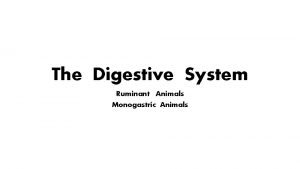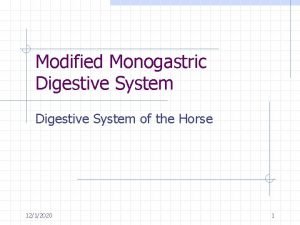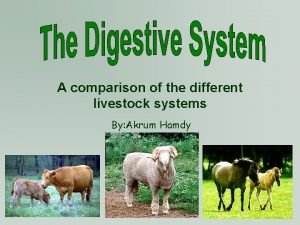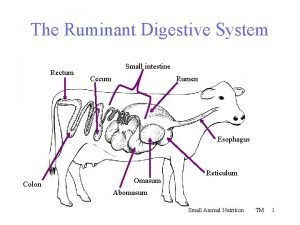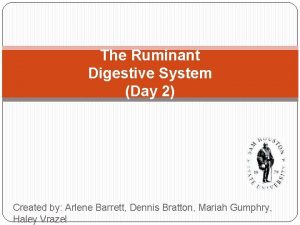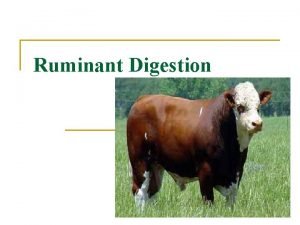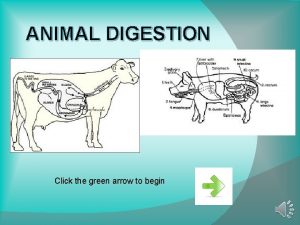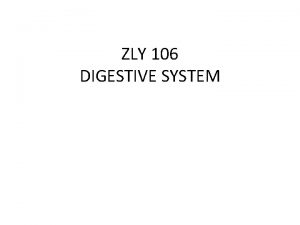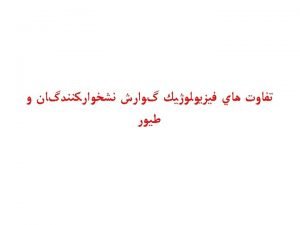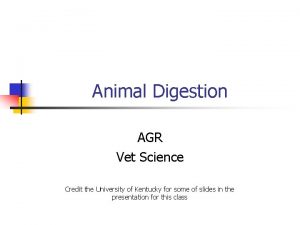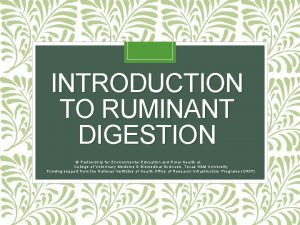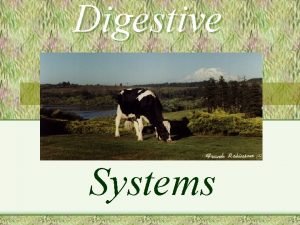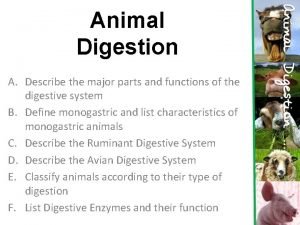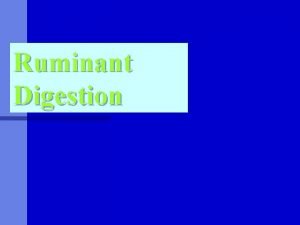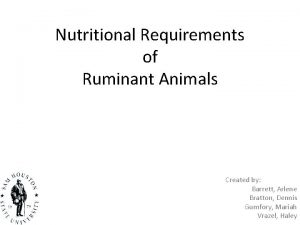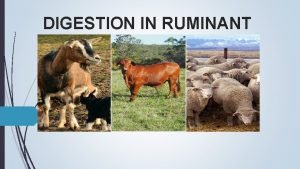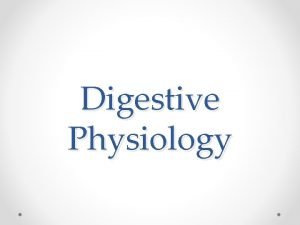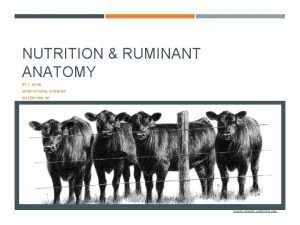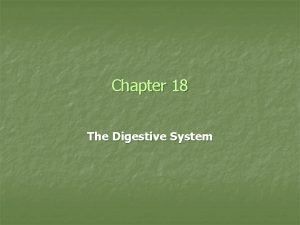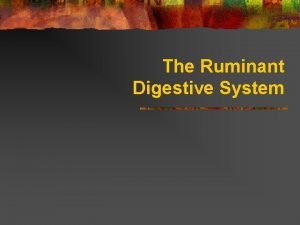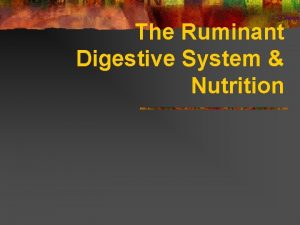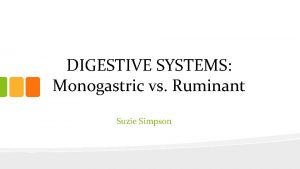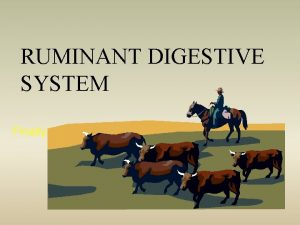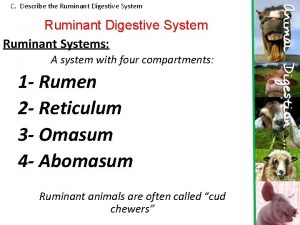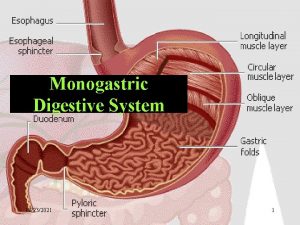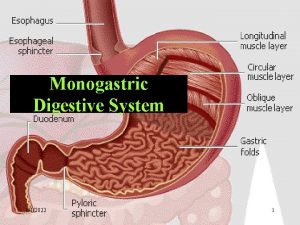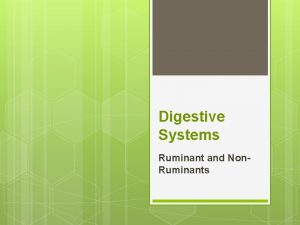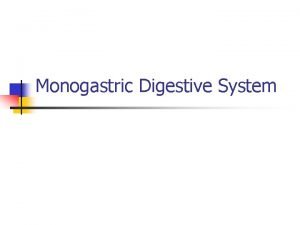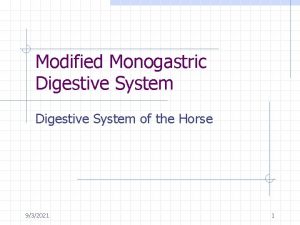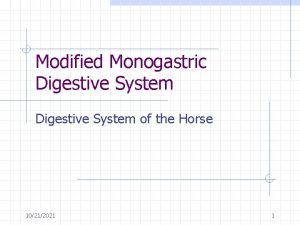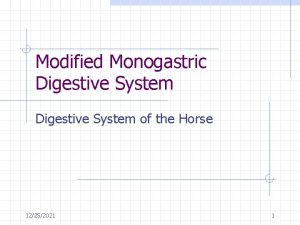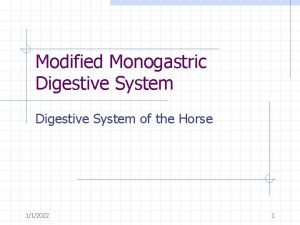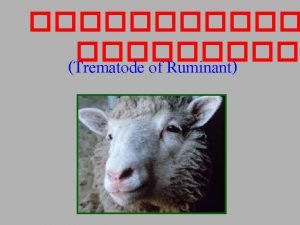The Digestive System Ruminant Animals Monogastric Animals The






















- Slides: 22

The Digestive System Ruminant Animals Monogastric Animals

The Digestive System • Animals need to digest food to provide energy. Energy is lost from the animals body in the following ways: ØMetabolism - all the chemical reactions that occur in an animals body e. g. Growth, Respiration, reproduction. ØExcretion - (urine or sweat) ØExercise. ØThe production of Heat and production of Faeces. ØCombating Illness.

The Digestive System of a Ruminant

Ruminant Animals • A ruminant animal has a stomach that is modified or adapted for the digestion of Cellulose. The stomach has four different chambers each with a special function. • The animal breaks down food in the mouth, passes it to the first chamber where partial digestion occurs. • Material is known as the “cud” and is regurgitated from the second chamber and chewed a second time before being swallowed and continuing through the remaining two chambers. • Cattle and Sheep are ruminants.

Cellulose § Cellulose is a polysaccharide Carbohydrate. Cellulose is composed of long chains of glucose molecules bonded together. § Cellulose is difficult to breakdown and for this reason it is used as fibre in the diet. § Glucose is the monosaccharide sugar that is made by plants (grasses) in photosynthesis.

The Ruminant Stomach • The ruminant stomach consists of four chambers: 1. The Rumen: ØFood that is swallowed is passed down the oesophagus to the rumen. ØRumen contains micro-organisms such as bacteria and protozoans that digest cellulose which is found in plants such as grass, hay and silage. ØThe rumen has an anaerobic environment – this means that there is no oxygen present in the rumen.

The Ruminant Stomach ØThe rumen ahs a Ph range of 6. 5 to 7. 0. ØThe microbes (bacteria and protozoans) break down the cellulose into glucose to provide energy for the animal. ØThe breaking down of Cellulose results in the production of Carbon dioxide and Methane gases. ØThe rumen contracts to force these gases out of the rumen but if gases are not expelled they cause Bloat.

The Ruminant Stomach • 2. The Reticulum ØSecond chamber of the ruminant stomach. ØResembles a honeycomb in appearance. ØResponsible for regurgitating partially digested material from the rumen back to the mouth for further chewing. This is known as “chewing the cud”. ØRegurgitate - means to bring food that has not been fully digested back up the throat and into the mouth.

The Ruminant Stomach 3. The Omasum ØThird chamber of the Ruminant stomach. ØFood that has been regurgitated for further chewing is passed to the omasum when it is swallowed. ØHas many layers of tissue. ØResponsible for squeezing the food and reabsorbing water and liquid from it.

The Ruminant Stomach 4. The Abomasum ØFourth chamber of the ruminant stomach. ØGastric juices in the form of enzymes are secreted here to breakdown proteins. ØBecause of the similarity between the abomasum and the monogastric stomach it is often called the “true stomach”.

Bloat • Occurs in animals that have been put on early grass or a sward high in clover. • Gases such as Carbon dioxide and Methane build up in the rumen and cannot escape. • The left handside of the abdomen becomes distended (expands) • A tube may be inserted in the rumen to release gas. • If Bloat is severe a trocar and Cannula is used by the vet. The trocar and Cannula are inserted through the abdomen into the rumen. The trocar is then removed leaving the Cannula which lets gases escape.

Acidosis • Occurs in ruminants when the p. H falls below 5. 5. • Below p. H 5. 5 the rumen stops moving which leads to loss of appetite, low milk yield, weight loss, loss of condition in the animal. • Acidic bacteria in the rumen develop and produce more lactic acid. • Acid can be absorbed through the walls of the rumen which can lead to death. • Feeding a diet high in concentrates or low in fibre leads to acidosis.

Symbiosis • Occurs when two different species exist together each for mutual benefit. • Example: Relationship between ruminant animals and microbes (bacteria and protozoans) in the rumen of the cow or sheep. The cow or sheep provide the bacteria and protozoans with a place to live and food (nutrients) In return the bacteria and protozoans provide the enzymes to breakdown the cellulose for the sheep or cow. • Bacteria and protozoans are also digested by the sheep or cow providing them with protein. • Bacteria and protozoans are also sources of vitamin E & K.

Digestion in the Young Ruminant • When calves or lambs are born they do not have a fully functioning ruminant digestive system. • Milk and milk replacer is brought straight to the abomasum for digestion. • As calves and lambs begin to feed on hay and straw cultures of micro-organisms(bacteria) develop in the rumen. • It takes about six weeks for the rumen and reticulum to fully develop in the calf or lamb.

Comparing the Diet of a Cow with that of a Calf • Fed Colostrum, then milk. • High protein diet. • Fed minerals & vitamins. • Access to hay & concentrates to encourage “scratch factor”. • At 6 weeks weaned to grass and water. • Cow • Has a low protein diet (unless is pregnant or recovering from an illness) • Eats a high fibre diet grass, hay, silage. • Is fed minerals e. g. Calcium, Magnesium, Selenium.

Comparing the Diet of Ruminants Versus Non Ruminants (Cow/ sheep) ØDiet high in fibre. ØEat grass, hay, silage and some concentrates. ØNot fed wide range vitamins and minerals. ØLess varied diet. ØFed crude protein. Monogastric (Pig) ØDiet low in fibre ØEat a balanced ration. ØFed minerals a nd vitamins. ØGiven varied diet. ØAre fed high quality protein e. g. Lysine.

“The Scratch Factor” • The scratch factor is the introduction of bacteria and protozoans into the rumen of the young calf/lamb. • Calves and lambs are born without these bacteria and protozoans in their rumen. • Bacteria and protozoans are introduced into the rumen by feeding calves and lambs hay, straw and concentrates.

The Small Intestine • Duodenum: first section of small intestine. Bile and pancreatic juices are secreted into the small intestine to help breakdown food and absorb nutrients through the thin intestinal wall. • Bile: secreted by the Liver and stored in the gall bladder. Function of Bile is to breakdown (emulsify) fats and lipids in duodenum. • Pancreatic Juice: contains enzymes such as lipase, trypsin and pancreatic amylase.

The Large Intestine • Consists of the Caecum and the Colon. • Main function is to absorb water and pass waste to the rectum for excretion through the anus. • Bacteria in the colon manufacture vitamin K, which is also absorbed by the body.

Products of Digestion • Protein is broken down into Amino Acids. • Carbohydrates are broken down into Glucose. • Fata are broken down into fatty acids and Glycerol.

Monogastric Animal (Pig)

Monogastric Animal (Pig) § Have only one stomach. § Cannot digest Cellulose. § Cellulose acts as fibre in the diet. § Food is passed directly from the Oesophagus to the stomach for digestion. § Assimilation and absorption of food are carried out the same way as in the ruminant.
 Monogastric animal
Monogastric animal What is this
What is this Modified monogastric digestive system
Modified monogastric digestive system Modified monogastric examples
Modified monogastric examples Digestive system of ruminants
Digestive system of ruminants Ruminants fourth stomach
Ruminants fourth stomach Ruminant stomach
Ruminant stomach Pseudo ruminant examples
Pseudo ruminant examples Deer digestive system
Deer digestive system Digestive system of buffalo
Digestive system of buffalo Chicken digestive system diagram
Chicken digestive system diagram Conclusion of digestive system
Conclusion of digestive system Ruminant stomach
Ruminant stomach Ruminant animals
Ruminant animals Monogastric animals
Monogastric animals Ruminant animals
Ruminant animals Ruminant animals
Ruminant animals Ruminant animals
Ruminant animals Respiratory system circulatory system digestive system
Respiratory system circulatory system digestive system Monogasc
Monogasc Macrominerals
Macrominerals Caillette jeune ruminant
Caillette jeune ruminant The hepatic portal vein empties into the ____.
The hepatic portal vein empties into the ____.
